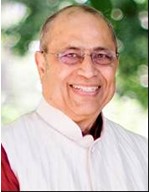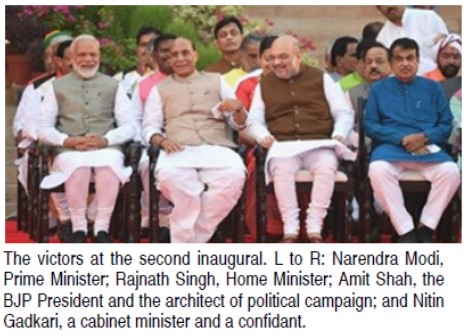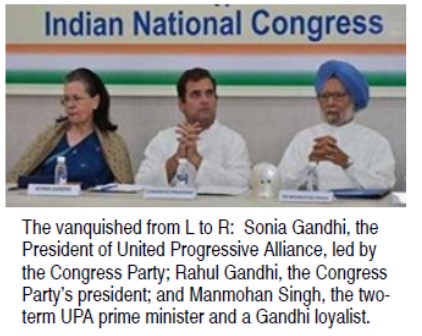By Deepak Kotwal, Squirrel Hill, PA
E-mail: deepak@kotwalfinancial.com

Editor’s Note: Deepak Kotwal, a long-time resident in our area, juxtaposes the Indian national elections with our own elections in the US.
The mother of all elections in the world is over and the results stunned the Western, and even the urban, Indian political pundits. Typically, Western media use suave English-speaking Indian interlocutors to interpret India for the West. These people are educated in elite and exclusive English medium schools, and often have no exposure to Indian history, languages, culture, ethos and India’s hinterland. Their urban and anglicized family upbringing has made it difficult for them to understand the complexities of a multi-lingual, multireligious, and ethnically diverse India, as happened in the 2019 election season. All their projections went haywire, with the Bharatiya Janata Party getting an absolute majority (with 303 seats out of 524), even better than what they got in 2014 (282 out of 543).
As a long-time American resident of Indian origin living in the US, several features contrasting the Indian and American systems come to my mind.
1. In the presidential system of the U.S., it is very difficult to remove the POTUS despite clear evidence of ethical violations, if   not crimes, committed by someone holding the highest elected office in the nation. In the Indian parliamentary  system, if a majority of the members of the parliament lose confidence in the PM, he/she can be removed by a no-confidence vote.
system, if a majority of the members of the parliament lose confidence in the PM, he/she can be removed by a no-confidence vote.
2. Elections in India are conducted by the Election Commission, an autonomous federal body with considerable independence once the elections are announced. In the US, the elections are conducted by state and local governments which have wide latitude in how they go about the process, resulting in gerrymandering and voter suppression rules in many Republican-controlled states. In India, on the other hand, the Election Commission goes to great lengths to ensure that every eligible voter goes to vote. Their logistical efforts to set up voting stations in remote villages for just a few voters are legendary. The Commission has a hard-earned reputation of integrity, fairness and being nonpolitical, having conducted 15 nation-wide national elections and countless elections for state legislatures.
3. Voter suppression efforts in the US emanate from its political/electoral DNA; a country established on land grab, genocide (of Native Americans) and slavery. When the US constitution was adopted in 1789, only property-owning, tax-paying white males were allowed to vote. In deciding how many seats there would be in the Congress, the famous — or infamous, depending on perspective — Three-Fifths Compromise was made. This allowed slave-owning states to count only 3/5th of the number of slaves in determining the population, and the number of representatives in Congress. It took the Civil War of 1865 and the subsequent 15th Amendment of 1870 to grant voting rights to African American slaves, still only to males. The Civil War took place in a country of only two ethnicities (European whites and African Slaves), one language (English), and one religion (Christianity). Contrast this with the enormously complex India, shown in the box above.
4. Even though the Confederates lost, subsequent years saw the rise of Jim Crow segregation to  deny political gains for former slaves. Suppression of Black voters and efforts to show that Whites were still in charge were strengthened, the symbol of which are the monuments for confederate generals installed after the war, even though they lost the war.
deny political gains for former slaves. Suppression of Black voters and efforts to show that Whites were still in charge were strengthened, the symbol of which are the monuments for confederate generals installed after the war, even though they lost the war.
5. The verb “to grandfather†(to exempt from new legislation or rules) arose from these efforts. Since the newly freed slaves were illiterate, a new requirement was promulgated that a voter must be able to read and write. This would have resulted in disenfranchising all the whites who were illiterate. To get around it and to enable the affected whites to vote, an exception was carved out — “if your grandfather was allowed to vote, then you get to vote.†Obviously, the newly freed slaves’ grandfathers were not allowed to vote. Hence the VERB grandfather!
6. Women fought through the Suffragist Movement to get voting rights obtained in the 19th Amendment adopted in 1920,  131 years after independence in 1776. Only in 1924 were Native Americans allowed to vote. Voting rights to all was granted in the Indian Constitution at the outset of 1950. The vigorous efforts of the Indian Election Commission to facilitate all to vote stands in stark contrast to US history, where we still are discussing voter suppression efforts.
131 years after independence in 1776. Only in 1924 were Native Americans allowed to vote. Voting rights to all was granted in the Indian Constitution at the outset of 1950. The vigorous efforts of the Indian Election Commission to facilitate all to vote stands in stark contrast to US history, where we still are discussing voter suppression efforts.
An undisputed star of the mechanics of the Indian election is the Electronic Voting Machine, each costing about US$250. These are designed and built by Bharat Electronics Limited, Bengaluru; and Electronics Corporation of India, Hyderabad. They are stand-alone battery-operated digital devices not connected to the internet. The same engineers who work on India’s atomic weapon systems and ballistic missiles worked on designing the EVM. In the US, voting methods vary from state to state. Some states still use paper ballots. With these electronic devices in India, the election results are out within fifteen hours after the start of the counting of over 600 million votes.
The US likes to bill itself as the beacon of democracy in the world. The next time you read a patronizing article about Indian elections in the Western press, just be knowledgeable about the history of the mechanics of US democracy vs. the Indian one. ♠
